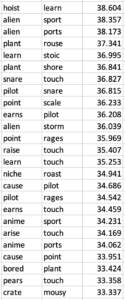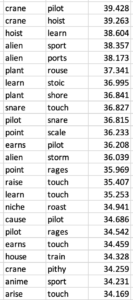I was recently introduced to the New York Times Word Games (Wordle, Spelling Bee, Connections, and Connected Box). It has been fun to learn strategies. To help get organized, I decided to write some Python programs to help my strategy and tactics.
Wordle
I started developing a program to narrow down the guesses for Wordle. It’s especially helpful if one gets near the end.
An attempt was made to determine the best initial guess words for Wordle. This was done by starting with an Internet list of the common words people use to start their Wordle guesses. The following were selected as trial words:
about, adieu, audio, canoe, great, irate, learn, least, media, raise, roast, roast, roate, soare, stare, stare, storm, trace
A Python program was written to pick two words from this list and then apply them to each word in the TWL3 dictionary as if they were the first two guesses in Wordle. The program found exact matches (green), partial matches (gold), and no matches (gray). Then, the program narrowed down the list of possible words that could fit. If 20 words fit the pattern, it implies a 5% chance of getting it right. If only one word fits the pattern, then the score is 100%. This scare was computed for all entries in the dictionary and averaged. This was redone for each combination of the trial words. Here is the ranking for the top 25 combinations:
The top combination was adieu and storm. The score of 14.106 implies that using these words would result in a little more than 14% of getting the answer correct by randomly choosing a word from the list of potential words that remain after entering these as the first two guesses.
Note that many words in the TWL3 dictionary are unlikely to be chosen by the Wordle team to be found. So, this approach underpredicts the percentage. However, the trends look as expected.
It takes about 15 minutes to score a pair of words against the TWL3 dictionary, so searching the entire dictionary for pairs of words would take weeks of computer time. TWL3 has 9403 five-letter words.
As the next step, more words were added to the trial pairs. Dictionary.com had a nice collection that their Wordle experts use, plus a collection they compiled. This boosted the testing to 86 trial words.
“about”,”adieu”,”aisle”,”alien”,”alter”,”anime”,”aorta”,”arise”,”aside”,”audio”,
“bacon”,”beaut”,”bored”,”canoe”,”cause”,”crate”,”crack”,”crest”,”earns”,”earth”,
“eight”,”farts”,”feast”,”great”,”group”,”harpy”,”heart”,”hoist”,”ideal”, “ideas”,
“ingot”,”irate”,”laugh”,”learn”,”least”,”loyal”,”meany”,”meats”,”media”,”mousy”,
“niche”,”noise”,”notes”,”omega”,”onery”,”opera”,”peace”,”pears”,”pilot”,”pithy”,
“plant”,”point”,”ports”,”power”,”prior”,”quest”,”rages”,”raise”,”rates”,”ratio”,”rents”,
“roast”,”rouse”,”scale”,”shape”,”shore”,”snare”,”soare”,”sport”,”stare”,”steak”,
“stern”,”stoic”,”stony”,”store”,”storm”,”table”,”teams”,”tears”,”those”,”tired”,
“touch”,”train”,”trace”,”water”,”yeast”,”youth”
Then, the Word Unscrabbler website was consulted. Scraping its list of 2000+ words created a newer, slimmer dictionary. The trial list was compared, and about 25 words needed to be added to the new slimmer dictionary (which means the dictionary may be too slim). The new list ended up with 2329 words.
The new top 25 words pairs came out as below (with much higher scores):
Interestingly, just as I was ready to publish this post, the New York Times distributed a newsletter post on how to do better at Wordle. They used statistics collected by users. They looked at historical results for the past year to compare the choice of the first word against the likelihood of getting a solution within the 6 allowed guesses. They reported that the first word most used by game players is adieu. However, of the top words people use, it ranks last in getting to a solution within the 6 allocated tries.
The New York Times reports that the users who use slate as their starting word get the best results measured by the likelihood of getting a solution within 6 guesses. Here is a distribution of results:
Actually, my strategy is significantly different. My program was looking for the best two initial words that make it more likely one can get the answer on the third try. The New York Times had 5 words in their list of most used initial words that weren’t on my list. So I added these 5 words and reran the program. The new trial word list is:
"about","adieu","aisle","alien","alter","anime","aorta","arise","arose","aside","audio", "bacon","beaut","bored","canoe","cause","crane","crate","crack","crest","earns","earth", "eight","farts","feast","great","group","harpy","heart","hoist","house","ideal", "ideas", "ingot","irate","laugh","learn","least","loyal","meany","meats","media","mousy", "niche","noise","notes","omega","onery","opera","peace","pears","pilot","pithy", "plant","point","ports","power","prior","quest","rages","raise","rates","ratio","rents", "roast","rouse","scale","shape","shore","slate","snare","soare","sport","stare","steak", "steam","stern","stoic","stony","store","storm","table","teams","tears","those","tired", "touch","train","trace","water","yeast","youth"
The new results are reported here:
Other Programs
I also wrote programs to help solve Spelling Bee (not a big deal, as there are dozens online) and Connect Box. My Connected Box program looks for all 1-word and 2-word solutions. So far, none of the challenges by the New York Times have a 1-word solution. Most have numerous 2-word solutions.
Share this Post





